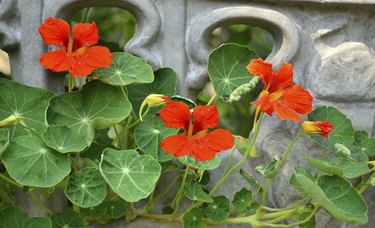
Both the leaves and flowers of nasturium (Tropaeolum majus) are edible, and have a peppery taste similar to watercress (Nasturium officinale), an aquatic plant to which it is botanically related. Poor growing conditions, a lack of water and infestations of aphids or whiteflies are the chief causes of yellowing, dying nasturtium leaves.
Shade and Fertilizer
Video of the Day
Grow nasturtiums in full sun. Their leaves won't be a healthy green if you try to grow them in shade. While you may associate yellow leaves with a lack of plant nutrients, that's not the case with nasturtiums. Fertilizing them in all but poor soil will do nothing for yellowing leaves and will prevent flowering. Nasturtiums grow as a perennials in U.S. Department of Agriculture plant hardiness zones 9 through 11. Plant them in spring and grow them as annuals in USDA zones 4 through 8. Watercress will grow in USDA zones 3 through 11.
Video of the Day
Lack of Water
Nasturtiums prefer loamy or sandy soils and you must keep the soil moist. A lack of water will cause the leaves to turn yellow. When nasturtiums are stressed, they're also more likely to be attacked by aphids. You can kill nasturtium roots by watering the plants too much. The leaves turn yellow as their roots die.
Aphids
Aphids can suck the fluid out of nasturtium leaves, causing them to turn yellow and die. These pear-shaped insects may be brown, yellow, green, black or red, depending on the species. You can release commercially available ladybugs on your plants or apply a silver-colored mulch on the ground. If you use the mulch, you'll need to install drip irrigation. You can also hose aphids off with water or smother them with by spraying the plant with a ready-to-use horticultural oil. Make sure you spray the undersides of the leaves as well as their tops and do not spray when your nasturtiums are water stressed or the temperature is above 90 degrees Fahrenheit. Wear protective clothing and goggles when applying horticultural oil and read the label for additional safety information.
Whiteflies
Whiteflies typically form colonies on the bottoms of leaves where they suck sap, causing the leaves to turn yellow. They excrete a substance called honeydew that can serve as a growing medium for black sooty mold. You can deter whiteflies with aluminum foil or reflective mulch, although you will have to use drip irrigation. To build homemade whitefly traps, cover pieces of flower-sized 1/4-inch-thick plywood with yellow paint, put them on pointed stakes and drive the stakes into the ground near your nasturtiums. Cover the tops with a mixture of household detergent and petroleum jelly. The aphids will be attracted to the yellow surfaces of your traps and stick to them. Clean off the traps when they're full of dead insects or debris. You can spray the leaves with ready-to-use neem oil to kill nymphs or immature whiteflies. Neem oil, a naturally occurring insecticidal oil, will not kill adult whiteflies and you have to cover the nymphs completely with the spray. Do not spray with neem oil if the temperature is above 80 F or your nasturtiums are suffering from drought stress. Wear a long-sleeved shirt, long pants and goggles and follow the safety instructions on the neem oil's label.
- University of California Statewide Integrated Pest Management Program: Nasturtium—Tropaeolum spp.
- Floridata: Tropaeolum Majus
- University of Florida IFAS Extension: Nasturtium, Garden -- Tropaeolum Majus L.
- University of California Statewide Integrated Pest Management Program: Nutrient Disorders
- Wisconsin Master Gardener: Nasturtium
- University of Oklahoma Department of Microbiology & Plant Biology: Tropaeolum Majus
- Plants for a Future: Nasturtium Officinale
- Old Farmer’s Almanac: Nasturtium
- University of California Statewide Integrated Pest Management Program: Aphids
- University of California Statewide Integrated Pest Management Program: Water Excess or Deficiency
- University of California Statewide Integrated Pest Management Program: Whiteflies